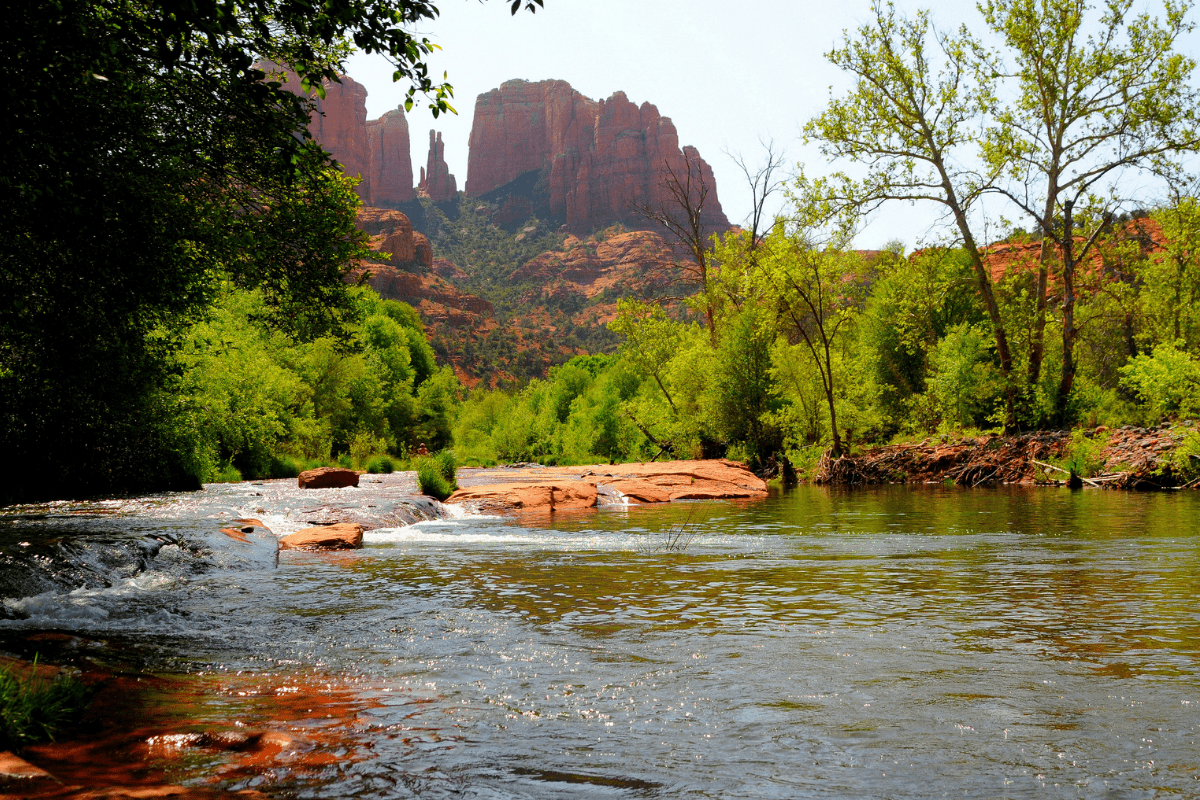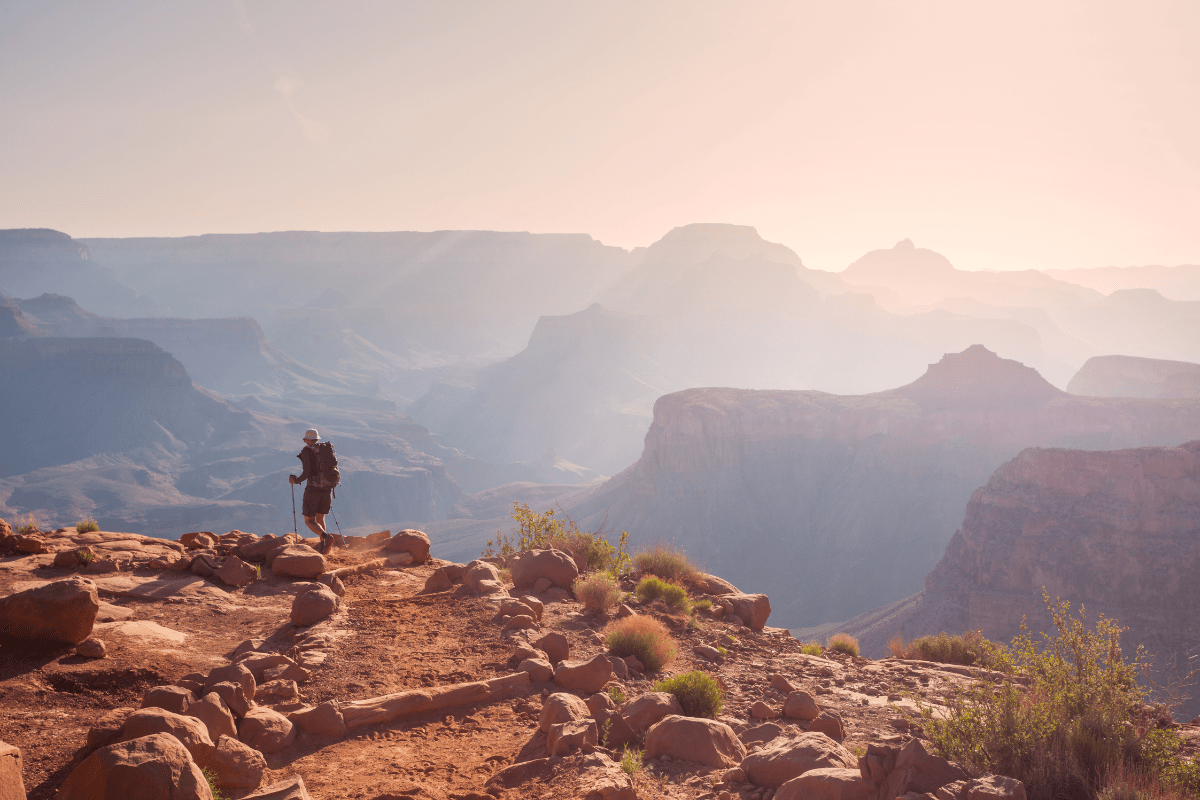Arizona's dramatic elevation changes create an extraordinary travel paradox: while Phoenix swelters at 115°F in July, Flagstaff…just 145 miles north…enjoys comfortable 81°F afternoons. This remarkable climate diversity means Arizona offers ideal travel conditions somewhere in the state year-round, but knowing when and where to visit makes all the difference between a memorable adventure and a miserable experience.
Spring in Arizona: The Golden Season (March-May)
Spring represents Arizona's tourism sweet spot, when desert wildflowers carpet the landscape and temperatures hover in that magical goldilocks zone of 70-85°F across most destinations. The season peaks in March and April, bringing comfortable weather statewide before summer's heat crashes the party like an unwelcome relative.
Phoenix and Scottsdale: Baseball and Blooms
Phoenix transforms into baseball central during spring, with Cactus League games running from February 20 through March 25. Picture this: 15 MLB teams playing across 10 stadiums while you're sitting in perfect 77°F weather, cold beer in hand, pretending you understand the infield fly rule. March temperatures average those delightful 77°F highs and 53°F lows, though by May you're looking at 93°F days that hint at the inferno to come.
Here's what makes spring special in the Valley of the Sun:
- Baseball spring training everywhere
- Perfect pool weather arrives
- Scottsdale Arts Festival draws crowds
- Desert wildflowers if lucky
- Hotel prices reach annual peak
- Barrett-Jackson car auction excitement
- Outdoor dining actually enjoyable
- Hiking before dawn unnecessary
The catch? Hotel rates spike 85-90% above summer prices, particularly in Scottsdale where luxury resorts can exceed $500 nightly during peak March weekends. Book 60-90 days ahead unless you enjoy paying mortgage-sized hotel bills.
Tucson: The Cooler Desert Alternative
Sitting at 2,400 feet elevation, Tucson runs 10-15°F cooler than Phoenix year-round, which doesn't sound like much until you're hiking in April's 74°F highs instead of Phoenix's 84°F. The city receives more rainfall too (12 inches annually versus Phoenix's 8), supporting more diverse desert blooms that actually show up most years instead of once per decade.
Spring in Tucson offers perfect conditions for exploring Saguaro National Park, where those iconic cacti look particularly photogenic against wildflower carpets. As a UNESCO City of Gastronomy, the outdoor dining scene thrives when you can actually sit outside without melting into your margarita.
Mountain Towns: Spring's Hidden Gems
Sedona's red rocks create stunning backdrops for spring adventures, with temperatures ranging from crisp 35°F mornings to pleasant 75°F afternoons. The 4,500-foot elevation means you'll want layers, but the moderate climate makes all 200+ hiking trails accessible. Just remember that everyone else knows this too…peak visitation means booking accommodations months ahead.
The quirky mining towns shine in spring:
- Bisbee at 5,350 feet: 60s-80°F perfection
- Tombstone's daily gunfights: Actually bearable to watch
- Jerome's galleries: Browsable without AC breaks
- Prescott's Whiskey Row: Patio season begins
Summer in Arizona: A Tale of Two Climates (June-August)
Summer divides Arizona into two distinct worlds: the scorching low deserts where stepping outside feels like opening an oven door, and the pleasant high country offering refuge with temperatures 30-40°F cooler. Understanding this elevation-temperature relationship…roughly 5°F cooler per 1,000 feet up…becomes your survival guide.
Flagstaff: Arizona's Summer Star
While Phoenix residents huddle indoors, Flagstaff basks in glory at 7,000 feet elevation. July highs average just 81°F with overnight lows of 51°F, and the city has never officially hit 100°F. That's right, never. Summer brings festivals nearly every weekend from May through October, including the Flagstaff Shakespeare Festival where you can watch Hamlet without heat stroke.
The Arizona Snowbowl operates scenic gondola rides to 11,500 feet in summer, where temperatures drop another 20°F and the views stretch to the Grand Canyon. The surrounding Coconino National Forest offers endless trails through the world's largest ponderosa pine forest, where the only sweating you'll do is from actual hiking, not just existing.
Mountain Escape Routes
Payson sits at 4,900 feet below the spectacular Mogollon Rim, running 12-15°F cooler than Phoenix. This makes it Phoenix's favorite summer escape, where temperatures typically range from 60-90°F. The area offers mountain lakes, cool forests, and that 200-mile-long cliff called the Mogollon Rim that looks like nature's version of a giant step.
Williams combines Route 66 nostalgia with mountain coolness at 7,000 feet. Summer temperatures in the 70s-80°F make it perfect for:
- Grand Canyon Railway adventures
- Bearizona drive-through wildlife park
- Historic downtown strolling
- Evening outdoor dining
- Pretending you're not from Phoenix
- Actually sleeping without AC
When Phoenix Becomes Mordor
Let's be honest about Phoenix in summer: it averages 104-106°F with overnight "lows" that barely drop below 80°F. Your car becomes a mobile furnace, door handles turn into branding irons, and the simple act of walking to your mailbox requires hydration planning.
But here's the secret: hotel rates drop 60-70% from peak season. World-class resorts practically give rooms away, their elaborate pool complexes becoming aquatic refuges. If you can handle the heat (or just plan to move between air-conditioned spaces like a desert vampire), summer offers incredible luxury deals.
Monsoon season runs June 15-September 30, bringing dramatic afternoon thunderstorms that temporarily break the heat. These storms deliver 50% of southern Arizona's annual rain, spectacular lightning shows, and occasionally, haboobs…massive dust storms that look like something from a disaster movie.
Fall in Arizona: The Perfect Balance (September-November)
Fall might be Arizona's best-kept secret, offering comfortable temperatures statewide, smaller crowds than spring, and hotel prices that won't require a second mortgage. September still runs warm, but by November, you've hit weather perfection across virtually every elevation.
Sedona's Autumn Magic
Sedona reaches peak beauty in fall, with September's toasty 94°F highs cooling to November's perfect hiking weather. Oak Creek Canyon's cottonwoods turn golden, creating a surprisingly authentic fall color experience in a state better known for cacti than changing leaves. The October Sedona Arts Festival capitalizes on the comfortable weather, though "comfortable" in September still means starting hikes at dawn.
Northern Arizona's Color Show
Flagstaff's aspens steal the show from late September through mid-October, with entire mountainsides turning golden. The Snowbowl Scenic Chairlift operates weekends for leaf peeping at elevation, where you can pretend you're in Colorado while paying Arizona prices.
The quirky mountain towns hit their stride in fall:
- Jerome's galleries: Browsable in comfort
- Page's lake activities: Perfect temperatures
- Prescott's courthouse square: Actually pleasant
- Payson's rim country: Ideal hiking weather
- Williams' Route 66: Classic car weather
Southern Arizona's Second Spring
By October, Tucson emerges from summer hibernation as temperatures drop from September's 96°F to November's glorious 78°F. The desert hiking trails become accessible again without requiring 4 AM start times, and outdoor restaurant patios fill with people remembering what fresh air feels like.
Bisbee and Tombstone experience their second peak season in fall, with October's Helldorado Days celebrating Wild West heritage in actually bearable weather. These high desert towns maintain temperatures in the 70s-80°F, perfect for wandering historic districts without seeking AC refuge every ten minutes.
Winter in Arizona: Desert Warmth and Mountain Snow (December-February)
Winter showcases Arizona's most dramatic personality split. Phoenix basks in 66°F sunshine while Flagstaff gets buried under 108 inches of annual snowfall. This season offers both America's warmest winter destination and legitimate skiing within a two-hour drive…though that drive might require chains.
Phoenix and Scottsdale: Snowbird Paradise
Winter brings the great snowbird migration, when seemingly half of Canada and the Midwest descends upon Phoenix like a polite, golf-club-wielding invasion. December temperatures average those perfect 66°F highs and 45°F lows that make you forget winter exists elsewhere. Golf courses overflow, hiking trails get crowded by 8 AM, and every restaurant patio fills with people FaceTiming frozen relatives back home.
The events calendar explodes:
- Barrett-Jackson auction brings car chaos
- Phoenix Open creates golf mayhem
- Spring training starts February
- Art festivals multiply exponentially
- Hotel rates reach maximum pain
- Traffic increases dramatically
- Restaurant waits grow longer
- Perfect weather continues daily
Hotel rates peak at 85-90% above summer rates from January through March, with March representing the absolute peak when spring training coincides with perfect weather.
Flagstaff: Arizona's Winter Wonderland
Flagstaff transforms into a legitimate winter destination with downtown snowfall averaging 108 inches. The Arizona Snowbowl operates from mid-November through mid-May with 55 runs across 777 acres. Yes, you can ski in the morning and golf in Phoenix that afternoon, though the drive might test your commitment to that plan.
Winter temperatures regularly drop to 10°F, so this isn't "throw on a light jacket" weather. The 2.5-hour drive from Phoenix can involve dramatic weather changes requiring serious preparation. Chain requirements exist, snow happens, and ice is real…basically everything Phoenix residents fear most.
Southern High Desert Winter
The high desert towns offer winter's sweet spot. Bisbee at 5,350 feet occasionally receives Instagram-worthy snow dustings while maintaining 50s-60°F temperatures. Tombstone provides comfortable weather for touring without summer's oppressive heat or Flagstaff's actual winter.
Lake Havasu City stays mild with winter temperatures between 45-70°F. While water sports slow down, the famous London Bridge looks particularly good without heat shimmer, and desert hiking becomes delightful.
Practical Planning: Making Your Arizona Dreams Reality
Understanding Arizona's seasonal patterns helps, but practical details make or break your trip. The monsoon season brings unique hazards including flash floods that turn dry washes into raging rivers and dust storms that reduce visibility to zero. Winter mountain travel might require chains or 4WD vehicles, especially after storms.
Wildlife and Natural Wonders
Nature follows its own schedule in Arizona. Sandhill cranes arrive by thousands at Whitewater Draw from November through March. Desert wildflower blooms require specific winter rainfall patterns, creating spectacular displays perhaps once per decade but offering good local shows every 3-4 years.
Peak wildflower timing:
- Low desert: Mid-March through April
- Middle elevations: April into May
- High country: May to June
- Monsoon wildflowers: August to September
The Hotel Pricing Game
Arizona's hotel rates follow predictable patterns that you can game if flexible. Desert destinations charge peak rates January through April, with March representing maximum pain. Mountain areas peak during summer escape season and winter ski months.
For budget travelers, Phoenix in summer offers spectacular resort deals at 60-70% off…if you're willing to experience what surface-of-Mercury temperatures feel like. Fall provides the best value statewide with moderate prices and comfortable weather.
Your Perfect Arizona Season
After all this weather data and temperature talk, choosing your season comes down to priorities. Want ideal weather everywhere? Spring delivers but charges accordingly. Seeking dramatic hotel savings? Summer in Phoenix offers luxury for less than a Motel 6 in March. Love winter sports or escaping cold? Arizona provides both, just 100 miles apart.
The beauty of Arizona lies not just in its diverse landscapes but in its year-round appeal. Whether you're seeking warm winter sunshine, cool summer mountains, or those perfect spring days that make you wonder why you live anywhere else, success comes from matching your destination to the season. Just remember: in Arizona, paradise is always available somewhere…you just need to know which elevation to visit when.





